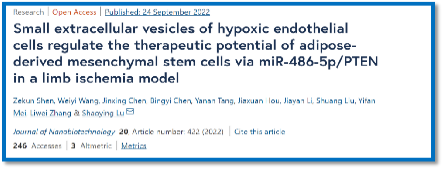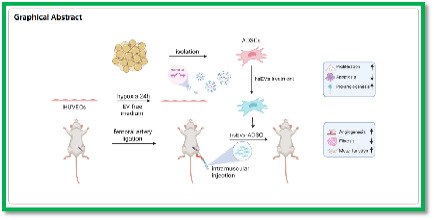Recently, the team from Department of Vascular Surgery of the First Affiliated Hospital of Xi 'an Jiaotong University (XJTU) published an online Article entitled "Small extracellular vesicles of hypoxic endothelial cells regulate the therapeutic potential of adipose-derived mesenchymal stem cells via miR-486-5p/PTEN in a limb ischemia model" in the prestigious Journal of Nanobiotechnology (IF: 9.429). The team identified small extracellular vesicles which can enhance the survival of stem cell transplantation, which are expected to be applied in the treatment of limb ischemic diseases in the future. Professor Lu Shaoying is the corresponding author. Shen Zekun, a doctoral student, is the first author. This study was performed on the experimental platform of Translational Medicine Center of our hospital.

Critical limb ischemia (CLI) constantly leads to limb necrosis. At present, cell-based therapy has become one of the effective methods to promote tissue repair. Adipose-derived mesenchymal stem cells (ADSCs) can promote angiogenesis in the ischemic areas and form novel collateral circulation, which have been widely used to treat CLI. Intramuscular injection of ADSCs can improve the ankle-brachial index (ABI) and transcutaneous oxygen pressure, and prolong the pain-free walk time. ADSCs play a role in promoting angiogenesis and tissue regeneration through paracrine and immunomodulation in ischemic muscular tissues. However, the harsh microenvironment of injection sites, such as ischemia and inflammation, leads to early cell death. Therefore, improving the survival of ADSC after transplantation and increasing their potential in treating CLI has attracted intense interest.

The team led by Professor Lu Shaoying from Department of Vascular Surgery of our hospital found that small extracellular vesicles of hypoxic endothelial cells could enhance the resistance of ADSCs to hypoxia and enhance their proangiogenic capability in vitro. Besides, hypoxia could up-regulate the level of miR-486-5p in small extracellular vesicles of endothelial cells, significantly down-regulate PTEN and activate the AKT/MTOR/HIF-1α pathway, thereby affecting the survival and proangiogenic ability of ADSCs. In a hindlimb ischemia mouse model, small extracellular vesicles-primed ADSCs exhibited superior cell engraftment and resulted in better angiogenesis and tissue repair.